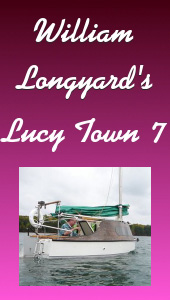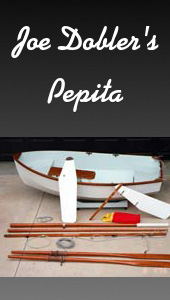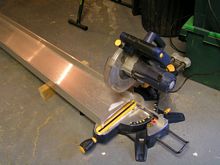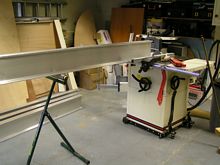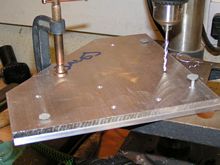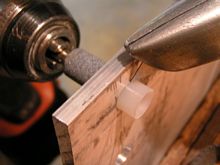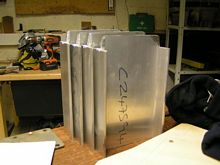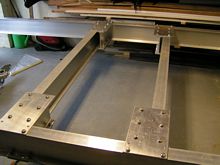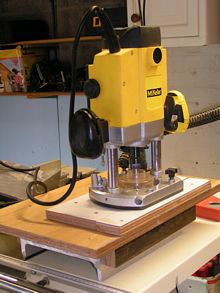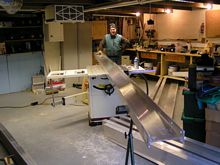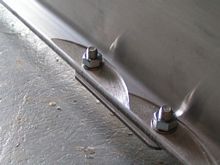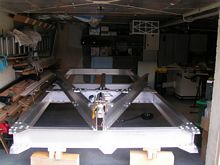
 Custom Search
|
| sails |
| plans |
| epoxy |
| rope/line |
| hardware |
| canoe/kayak |
| sailmaking |
| materials |
| models |
| media |
| tools |
| gear |
| join |
| home |
| indexes |
| classifieds |
| calendar |
| archives |
| about |
| links |
| Join Duckworks Get free newsletter CLICK HERE |
|
|
| Mike's Maritime Meanderings |
by Mike Machnicki
- London - England Building an Aluminium Trailer - Part Three |
 click for bio |
Part 3 of 4 - ConstructionPart One - Part Two - Part Three - Part Four Now it’s time to test out the theory. The previous two articles were just talk, this is where I get a few more scars on the hands. The first job is to cut up the I beams into the correct size pieces. At nearly 20 foot long they are too long and heavy to cross cut on the table saw, so I have to raise them with a few wooden blocks to get my chop saw underneath. There was a cheap blade on the saw which ended up like a toothless old hag after four cuts, it did manage to pay me back though by flicking a hot piece of aluminium into the corner of my lips, which took the grin away for a few hours. I would definitely recommend an aluminium cutting blade rather than a wood rip blade, or if you do use a wood blade, make it a medium cross cut blade. Lubricate it every half dozen cuts with a squirt of WD40 on each side, otherwise you will find the teeth get clogged. Aluminium chips aren’t like sawdust so it goes without saying that goggles and ear protectors are required and don’t think that you can get away without using the goggles because you wear glasses, you can’t - trust me on this one.
Once the beams had been cut down to size the cross pieces at 6’ 3” could fit onto the table saw to cut the tenons in the top and bottom rails at each end, to allow the rib to fit into the trailer side rails. After the first cross cuts, I slid the ends into the saw blade to cut the bits of top and bottom rail off. To avoid cutting too deep, because the circular blade was angled, even on full height, I finished the job off with a hack saw. With the rib exposed I shaped it with hacksaw and file on the four cross rails and four suspension stubs.
Next job was to cut the 8” x ¼” bar into smaller pieces to reinforce each joint on top and bottom. The only exception is the bottom of the four joints where the suspension will fit. The tops of the suspension units will be painted with 3 coats of epoxy to protect them and isolate them from the aluminium frame (as will the bottom of the coupling). With the reinforcing bar cut to size the bolt holes need to be drilled to take the shoulder washers. After careful measurement I decided to place the bolt centres at 16mm from the edge of the beams and 30mm from the ends. On each plate there will be 4 bolts into each beam, so either 8 or 12 holes to be drilled on each plate, depending on its profile and where it fits. There could be a number of successful ways of doing this, as the way used worked so well I can recommend it. Firstly measure and locate the hole centres with a centre punch. Drill small taping holes on one plate of each shape, then widen these holes to 3.5mm. Now take the other plates of the same shape, one by one, clamp to the plate with holes and drill using the first plate as a template. After each of the first 3 holes, put a small clout nail of the same diameter as the holes to prevent the plates moving. When all the plates have 3.5mm holes expand them to 8.5mm and then 12mm which was the outside diameter of the shoulder washers. On this last drilling, first drilled ¾ way through the holes from one side then turn over and drill through to prevent breakout. This gives holes in identical places to the extent that the tight fit shoulder washers could be pushed through two plates together (the washers were over length and will need to be cut down).
It just goes to show that you can’t think of everything, or at least I can’t. After having cut and drilled the plates over the suspension arms to size I decided that the stubs should be narrower for the suspension plate hole centres to be 16mm from the edge, this meant that the top plate holes were too wide, but I left them like that rather than re-drill.
Although the basic design of the trailer has already been done, there are still a few parts where I don’t quite know how to finish the details. One of these is the bunks – do I have longitudinal planks shaped to size, or cross members on the four cross rails to support planking? How do I keep the keel on the centre bunk – some sort of shoe or guide side rails will be a good idea maybe? These details will have to wait until the trailer is built, I am sure they will slip into place at the appropriate time. I just had a chat with my accountant who used to have an aluminium canal boat which he towed on a trailer. The boat was about 3 tons and ballasted with water, which towed very nicely behind his Landrover Discovery (the same as I drive). On one occasion he pulled the boat up the ramp to find the extra load of ballast water had bottomed the suspension, and as the mudguard brackets and bolts were over the wheel, the bolts had gouged two furrows in his front tyres. I don’t think this will happen to me as I have no water ballast, but it may be worth allowing a little extra space and not placing bolts over the centre of the tyres. IMPORTANT NOTE: Now for the first problem! When the aluminium beams were bought, I envisaged they would be like steel RSJs with a flat inside cross section on top and bottom. However when they arrived the top and bottom inside edges were chamfered and would need to be trimmed, to allow the washers to sit flat. This could turn out to be a large job, so I considered the options:
For the smaller beams that would fit easily on the saw I placed them on their sides against the guide and slid the ends into the saw blade (set to the right height) - this trimmed the aluminium to perfection. For the side rails, which were long and heavy, this method would not work. The new method was to place the beam in the right place with the saw blade on the lowest setting, then slowly wind up the blade to the correct height, on my saw this was 14 turns – again a perfect cut.
Not having a level building site makes the job a bit harder, the garage floor is not only sloping 4” from front to back but is also uneven so all the pieces of aluminium must be propped and levelled with wedges. The garage is about 19’ long, so I can just fit the body of the trailer without the draw bar with about 2” to spare, in fact the side rails needed to be adjusted by 3” to make them fit with the A frame fixing plates attached. After a few trial attempts I decided the trailer has to be constructed in a certain order to make it possible.
I now have a complete rectangular frame bolted with temporary BPZ nuts
This in essence is the sequence to complete the structure, but it will not fit in the garage, and it is still too cold and wet to consistently work outside so I will take off the A frame and complete the trailer body, adding it again at the last stage after wiring up the lights and brakes (to be covered in the next article on finishing off). After a bit of further research on the net I decided to modify the design and just use Locktite 2701 which is specially formulated for use with chrome alloys (a component of stainless steel), it has a quoted breakaway strength of 38Nm (28 foot pounds) which seem very little, so I phoned the technical helpline for advice and was told. “The quoted breakaway is a specific test where the nut is loose on the thread, if you torque the nut down it will not be possible to undo it, unless it is heated to about 250° C”. Not what the specification suggested. Don’t you just love the technical helplines, they provide the critical information that is missing from the specification. Click HERE for a list of articles by Mike Machnicki
|
|
